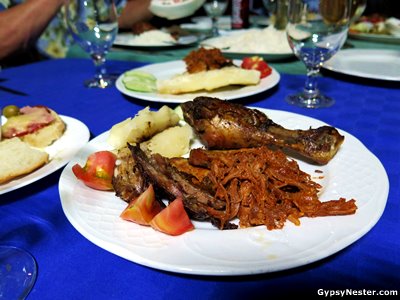
While we were preparing for our bicycling adventure in Cuba with Backroads Travel, we spoke with several people who told us not to expect much from the food. This fit right in with our preconceived notions of the island but, like most all of them, proved to be false.
Our expectations of bland beans, rice, and chicken were blown away by exciting dishes that incorporate the spices and techniques of Spanish and African cooking. Being on an island also means that the bounty of the sea plays an important role in the cuisine of Cuba.
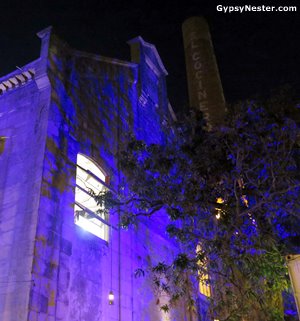 From our first night in Havana, to the farms and cafes we dined at across the countryside, we were pleasantly pleased with every single meal.
From our first night in Havana, to the farms and cafes we dined at across the countryside, we were pleasantly pleased with every single meal.
The rooftop restaurant we found the evening we arrived served delicious and innovative dishes with strong connections to the island’s culinary traditions. Chef Ramon Manuel Lopez Alarcon certainly delivered on El Cocinero Restaurant’s reputation as one of Cuba’s finest.
Far from the plain, uninspired cuisine we had been warned to expect, we dined on pork tenderloin with a creamy corn and coconut sauce and grilled Caribbean spiny lobster accompanied by pilaf and salad. Others in our group chose lamb curry and duck confit and were equally impressed.

As delicious as the entrées were, the deserts were truly the stars of the show. We ordered a couple to share around the table, including the house specialty chocolate tart and an innovative, as well as quite cute, take on rice pudding that came served like sushi.
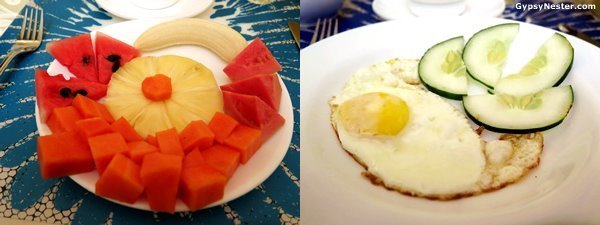
Breakfast the next morning was simple, yet elegantly presented, and we found this to be true throughout our journey. Artfully arraigned fresh tropical fruits, served along with eggs and an assortment of cheese, meats, and breads was the norm.
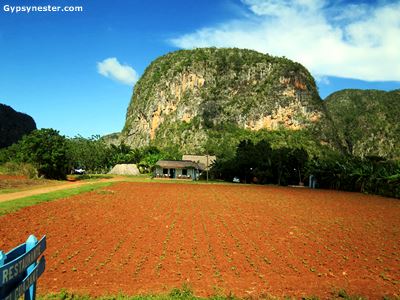
Lunches were also straightforward and practical, yet delectable and showed great attention to detail.
Before our ride one day we stopped at Restaurante El Cuajaní on a tobacco farm near the base of a magote in the Viñales Valley for fish roasted in a brick oven with mixed local veggies and mashed malanga. Even this Cuban version of down home cooking was plated with care and style.
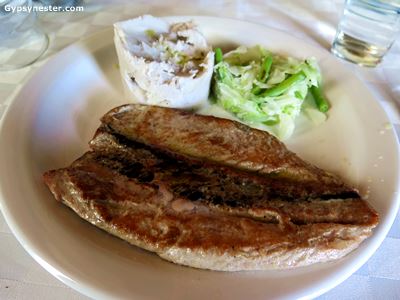 Thus we had our introduction to malanga, which is a root very similar to taro, and is the go to starch of the island. Over the next few days we would see it a lot, usually mashed, but also fried, stewed, baked, and as chips.
Thus we had our introduction to malanga, which is a root very similar to taro, and is the go to starch of the island. Over the next few days we would see it a lot, usually mashed, but also fried, stewed, baked, and as chips.
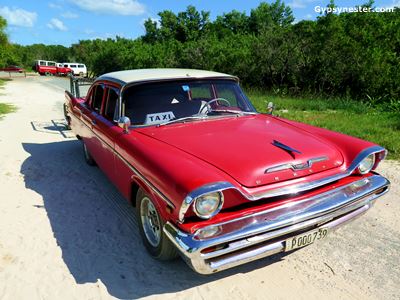 Another memorable lunch was served to us beachside at Playa deCayo Jutías. With our feet nearly in the ocean, how could we eat anything but fresh caught fish? Snapper with rice filled the bill nicely, and a ride back to the hotel in a 1957 De Soto Diplomat made it nearly a perfect afternoon.
Another memorable lunch was served to us beachside at Playa deCayo Jutías. With our feet nearly in the ocean, how could we eat anything but fresh caught fish? Snapper with rice filled the bill nicely, and a ride back to the hotel in a 1957 De Soto Diplomat made it nearly a perfect afternoon.
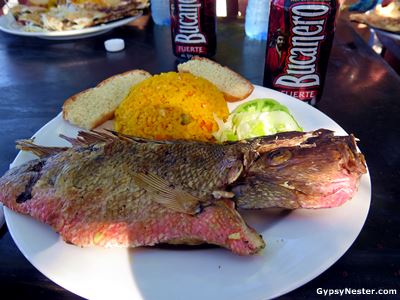 Such a day also requires some sort of liquid sustenance and we discovered two brews that fit right in, Bucanero and Cristal. Both are light and refreshing, Cristal somewhat lighter, and these were the only two beers we ever saw.
Such a day also requires some sort of liquid sustenance and we discovered two brews that fit right in, Bucanero and Cristal. Both are light and refreshing, Cristal somewhat lighter, and these were the only two beers we ever saw.
Rum is probably the most popular Cuban potent potable, with Havana Club being the big one, but don’t be fooled, the Havana Club sold in the states is not the real thing. It is made in Puerto Rico by Bacardi.
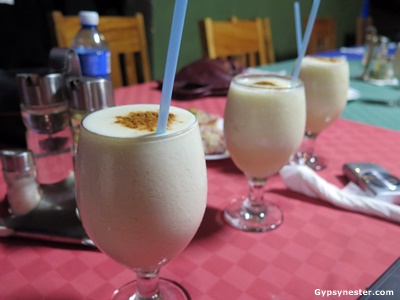 While the locals usually drink it straight, we were content to stick with fruity foo-foo drinks. Piña Coladas were everywhere, and the best we ever had, hands down.
While the locals usually drink it straight, we were content to stick with fruity foo-foo drinks. Piña Coladas were everywhere, and the best we ever had, hands down.
They sure came in handy the night we preceded dinner with Salsa dance lessons. We were loosened up nicely, made valiant attempts at shaking our booties, then dined on mini pizza style appetizers and a roast chicken and pork dinner served family style.
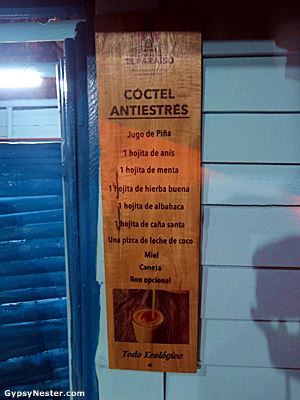 However, our most entertaining libation by far was the Coctel Antiestrés, or anti-stress cocktail. This was a perfect after tour and pre dinner break that we not only enjoyed, but also learned to make at our farm to table visit to Finca Agroecológica Paraíso.
However, our most entertaining libation by far was the Coctel Antiestrés, or anti-stress cocktail. This was a perfect after tour and pre dinner break that we not only enjoyed, but also learned to make at our farm to table visit to Finca Agroecológica Paraíso.
Pineapple juice, mint, canella, basil, anise, piper auritum, honey, and of course, rum are mixed, poured over ice, and served until any and all stress is removed. In our experience, that doesn’t take long.
With our tension levels near all-time lows we were ready for anything, even going whole hog so to speak. That is what the meal consisted of, a whole hog.
We got a behind the scenes before and after look at the process, then proceeded to enjoy some of the best roast pork we have ever tasted.
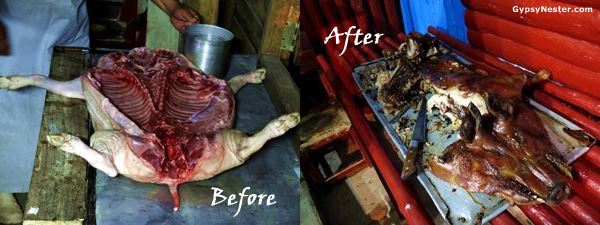
There is one last beverage that we cannot possibly overlook in our discussion of Cuban refreshments, coffee. Everywhere we went the java was pretty jammin’, but this night the joe, like everything else, was raised right on the premises organic farm to table.
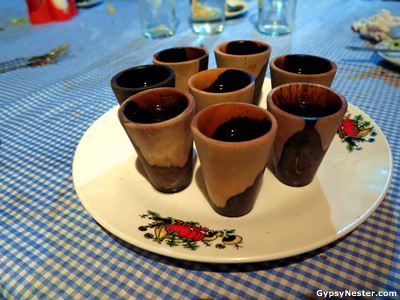 Also in keeping with the rest of the evening’s fare, the coffee was fantastic. Strong, but not too much, and served in the coolest little wooden shot glasses. So cool that a couple of them came home with us as souvenirs.
Also in keeping with the rest of the evening’s fare, the coffee was fantastic. Strong, but not too much, and served in the coolest little wooden shot glasses. So cool that a couple of them came home with us as souvenirs.
No, no. Not anything like that. No sneakiness.
We gladly paid for these reminders of how everything excided expectations.
David & Veronica, GypsyNester.com
A big thank you to Backroads Travel for providing this adventure, as always, all opinions are our own.



Cuba is a mix of cultures so I expect the food to be just delicious! Thank you for sharing your culinary experiences!
You’re certainly right, our pleasure.